

| Cavy Chronicles | A Day in the Lives of Three Cavies | Ask the Cavies | Cavy Resources |
Cross- Country Cavies |
Photo Album Page |
|
CAVIIDAE: Guinea Pig/Cavy Family There are about 15 species in this interesting and entirely South American family of ground-living rodents. Within the group are forms known as guinea pigs or cavies, mocos or rock cavies, and the Patagonian "hares," locally called "mares." Cavies and rock cavies have the well-known chunky body shape of domestic guinea pigs, with short ears and limbs, a large head and a tail which is not externally visible. Maras have a more harelike shape, with long legs and upstanding ears. Cavies feed on plant material, and their cheek teeth continue to grow throughout life to counteract the heavy wear caused by chewing such food. Most live in small social groups of up to 15 or so individuals; sometimes they join in larger groups of as many as 40. They do not hibernate, even in areas which experience low temperatures. | |
|
NAME: Cavy,
Cavia tschudii RANGE: Peru to N. Argentina HABITAT: grassland, rocky regions SIZE: body: 20-40 cm (7.75-15.75 in) tail: no visible tail
Cavy
These nocturnal rodents usually live in small family groups of
up to 10 individuals, but may form larger colonies in particularly
suitable areas. Although their sharp claws are well suited for
digging burrows, they often use burrows made by other species
or shelter in rock crevices. They feed at dawn and dusk, largely
on grass and leaves.
NAME: Rock
Cavy, Kerodon rupestris
Rock Cavy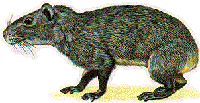
Similar in build to the cavy, the rock cavy has a longer, blunter
snout and longer legs. It shelters under rocks or among stones
and emerges in the afternoon or evening to search for leaves to
eat. It will climb trees to find food. |
NAME: Mara, Dolichotis
patagona RANGE: Argentina HABITAT: open arid land SIZE: body: 6975 cm (27.25-29.5 in) tail: 4.5 cm (l.75 in)
Mara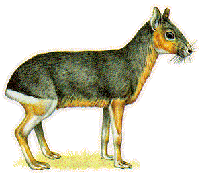
The mare has long, slender legs and feet well adapted for
running and bounding along at speeds as great as 30 km/h (18.5
mph) in the manner of a hare or jackrabbit. Indeed, the mare fills
the niche of the hare in an area where the latter is absent. |
|
HYDROCHOERIDAE: Capybara Family
This family contains only 1 species, the capybara, which is the
largest living rodent. It resembles a huge guinea pig with a large
head and square muzzle, and lives in dense vegetation near lakes.
rivers or marshes.
NAME: Capybara, Hydrochoerus
Capybara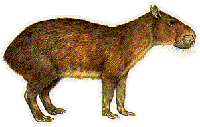
The capybara spends much time in water and is an excellent swimmer
and diver; it has partial webs between the digits of both its
hind feet and forefeet. When swimming, only its eyes, ears and
nostrils show above the water. Capybaras feed on plant material,
including aquatic plants, and their cheek teeth grow throughout
life to counteract the wear and tear of chewing. They live in
family groups and are active at dawn and dusk. In areas where
they are frequently disturbed, capybaras may be nocturnal.
DINOMYIDAE: Pacarana Family
This South American family contains 1 apparently rare species,
the false paca, or pacarana, so called because its striking markings
are similar to those of the paca.
NAME: Pacarana,
Dinomys branicki
Pacarana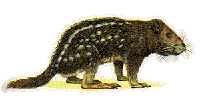
The pacarana is a slow-moving, docile animal with short, strong
limbs and powerful claws. It feeds on plant material, such as
leaves, stems and fruit, and sits up on its haunches to examine
and eat its food. Its cheek teeth are subject to considerable
wear and grow throughout its life. It is most probably nocturnal. |
DASYPROCTIDAKE: Paca and Agouti Family
The 12 species in this family are distributed throughout Central
and South America. All are medium to large ground-living rodents,
with limbs well adapted for running.
NAME: Paca,
Cuniculus pace
Paca
The nocturnal pace is usually a solitary animal. It spends its
day in a burrow, which it digs in a riverbank, among tree roots
or under rocks, emerging after dark to look for food. The pace
enters water willingly and will often escape from predators by
swimming. It is believed to produce two litters a year of 1, rarely
2, young.
NAME: Brazilian
Agouti, Dasyprocta aguti
Agouti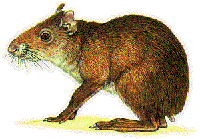
Agoutis are social animals and are active in the daytime. They
are good runners and can also jump up to 2 m (6.5 ft) vertically,
from a standing position. Agoutis dig burrows in a riverbank or
under a tree or stone and tread well-defined paths from burrows
to feeding grounds. They are believed to mate twice a year and
bear litters of 2 to 4 young. |

| Cavy Chronicles | A Day in the Lives of Three Cavies | Ask the Cavies | Cavy Resources |
Cross- Country Cavies |
Photo Album Page |